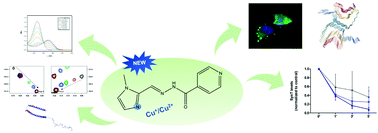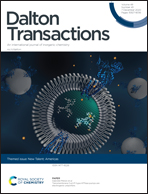X1INH, an improved next-generation affinity-optimized hydrazonic ligand, attenuates abnormal copper(i)/copper(ii)-α-Syn interactions and affects protein aggregation in a cellular model of synucleinopathy†
Abstract
Although normal aging presents an accumulation of copper and iron in the brain, this becomes more relevant in neurodegeneration. α-Synuclein (α-Syn) misfolding has long been linked with the development of Parkinson's disease (PD). Copper binding promotes aggregation of α-Syn, as well as generalized oxidative stress. In this sense, the use of therapies that target metal dyshomeostasis has been in focus in the past years. Metal–Protein Attenuating Compounds (MPACs) are moderate chelators that aim at disrupting specific, abnormal metal–protein interactions. Our research group has now established that N-acylhydrazones compose a set of truly encouraging MPACs for the bioinorganic management of metal-enhanced aggregopathies. In the present work, a novel ligand, namely 1-methyl-1H-imidazole-2-carboxaldehyde isonicotinoyl hydrazone (X1INH), is reported. We describe solution studies on the interaction and affinity of this compound for copper(II) ions showing that a fine tuning of metal-affinity was achieved. A series of in vitro biophysical NMR experiments were performed in order to assess the X1INH ability to compete with α-Syn monomers for the binding of both copper(I) and copper(II) ions, which are central in PD pathology. A preference for copper(I) has been observed. X1INH is less toxic to human neuroglioma (H4) cells in comparison to structure-related compounds. Finally, we show that treatment with X1INH results in a higher number of smaller, less compact inclusions in a well-established model of α-Syn aggregation. Thus, X1INH constitutes a promising MPAC for the treatment of Parkinson's disease.

- This article is part of the themed collection: New Talent: Americas


 Please wait while we load your content...
Please wait while we load your content...